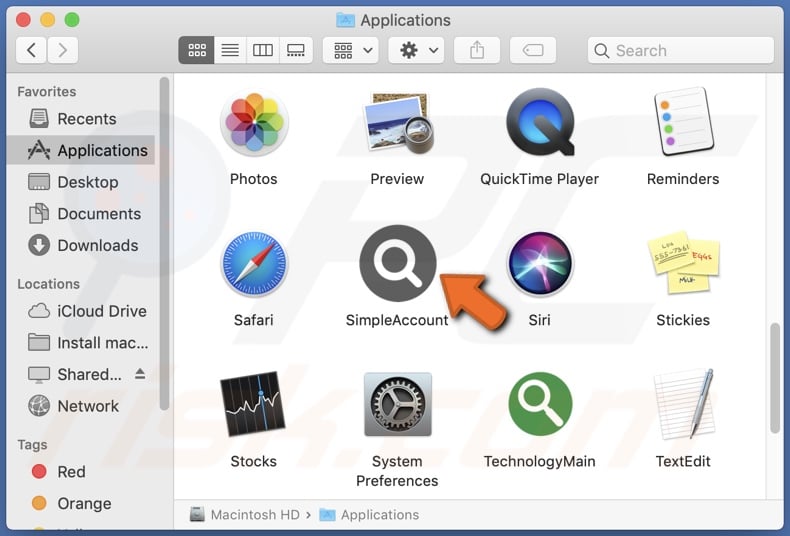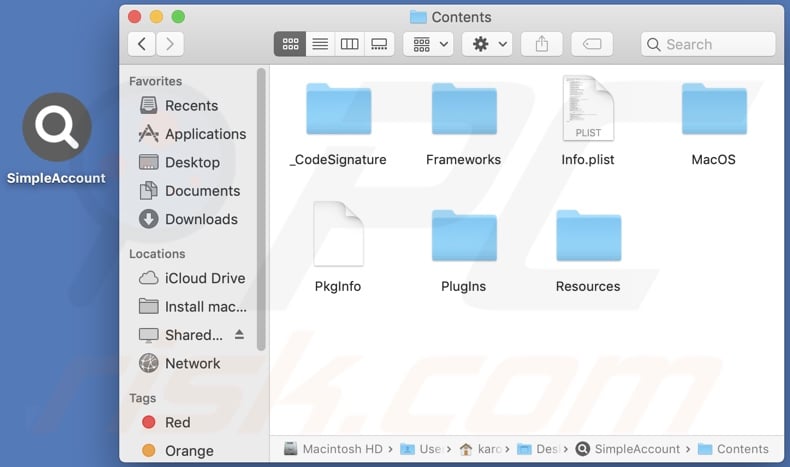How to uninstall SimpleAccount adware from your operating system?
Mac VirusAlso Known As: Ads by SimpleAccount
Get free scan and check if your device is infected.
Remove it nowTo use full-featured product, you have to purchase a license for Combo Cleaner. Seven days free trial available. Combo Cleaner is owned and operated by RCS LT, the parent company of PCRisk.com.
What is SimpleAccount?
SimpleAccount is a rogue app with adware and browser hijacker qualities. Furthermore, since most users inadvertently download/install software products of this type - they are also categorized as PUAs (Potentially Unwanted Applications).

SimpleAccount adware overview
Adware can display pop-ups, banners, coupons, and other intrusive adverts on visited sites and/or different interfaces. The delivered ads endorse sale-oriented, rogue, compromised, deceptive/scam, and malicious websites. What is more, some intrusive ads can download/install software (e.g., PUAs) stealthily - upon being clicked.
Browser hijackers cause redirects to fake search engines when new browser tabs/windows are opened and search queries are typed into the URL bar. The addresses of these web searchers are assigned as browsers' homepage, default search engine, and new tab/window URLs.
Illegitimate search engines are typically incapable of generating search results, so they redirect to Google, Yahoo, Bing, and other genuine ones. Hijacker software also uses persistence-ensuring techniques to prevent browser recovery.
SimpleAccount likely has data tracking abilities, which are typical for such apps. Targeted data includes - browsing and search engine histories, personally identifiable details, finance-related information, etc. This data is monetized through sale to third-parties (often, cyber criminals).
To summarize, the presence of unwanted software on devices can result in system infections, severe privacy issues, financial losses, and even identity theft.
| Name | Ads by SimpleAccount |
| Threat Type | Adware, Mac malware, Mac virus |
| Detection Names | Avast (MacOS:Adload-AG [Adw]), Combo Cleaner (Gen:Variant.Adware.MAC.AdLoad.13), ESET-NOD32 (A Variant Of OSX/Adware.Synataeb.G), Kaspersky (Not-a-virus:HEUR:AdWare.OSX.Adload.j), Full List (VirusTotal) |
| Additional Information | This application belongs to Adload malware family. |
| Symptoms | Your Mac becomes slower than normal, you see unwanted pop-up ads, you are redirected to dubious websites. |
| Distribution methods | Deceptive pop-up ads, free software installers (bundling), fake Flash Player installers, torrent file downloads. |
| Damage | Internet browser tracking (potential privacy issues), display of unwanted ads, redirects to dubious websites, loss of private information. |
| Malware Removal (Windows) |
To eliminate possible malware infections, scan your computer with legitimate antivirus software. Our security researchers recommend using Combo Cleaner. Download Combo CleanerTo use full-featured product, you have to purchase a license for Combo Cleaner. 7 days free trial available. Combo Cleaner is owned and operated by RCS LT, the parent company of PCRisk.com. |
Adware in general
ActiveOptimization, Ultratech, and TaskBoard are a few examples of adware. This software looks harmless and offers "handy" features, which are seldom operational. In fact, this applies to practically all PUAs. Functionality and user safety are irrelevant, as the only goal of unwanted applications is to generate profit for the developers.
How did SimpleAccount install on my computer?
PUAs can be downloaded/installed alongside other programs. This marketing method of packing regular software with various additions - is called "bundling". Intrusive adverts spread PUAs as well. Once clicked, the ads can execute scripts to make downloads/installations without user permission. PUAs can also have "official" download webpages.
How to avoid installation of potentially unwanted applications?
It is important to research software and download only from official and verified sources. Untrustworthy download channels, e.g., unofficial and freeware websites, Peer-to-Peer sharing networks, etc. - often offer bundled/harmful content.
When downloading/installing, it is advised to read terms, study possible options, and use the "Custom" or "Advanced" settings to opt-out of all supplements. Intrusive advertisements look innocuous, yet they redirect to various unreliable/dubious sites (e.g., gambling, pornography, etc.).
If such adverts/redirects are encountered, the system must be inspected and all suspicious applications and browser extensions/plug-ins detected - immediately removed. If your computer is already infected with SimpleAccount, we recommend running a scan with Combo Cleaner Antivirus for Windows to automatically eliminate this adware.
Pop-up window displayed once SimpleAccount adware's installation is over:
 SimpleAccount adware's installation folder:
SimpleAccount adware's installation folder:

Instant automatic malware removal:
Manual threat removal might be a lengthy and complicated process that requires advanced IT skills. Combo Cleaner is a professional automatic malware removal tool that is recommended to get rid of malware. Download it by clicking the button below:
DOWNLOAD Combo CleanerBy downloading any software listed on this website you agree to our Privacy Policy and Terms of Use. To use full-featured product, you have to purchase a license for Combo Cleaner. 7 days free trial available. Combo Cleaner is owned and operated by RCS LT, the parent company of PCRisk.com.
Quick menu:
- What is SimpleAccount?
- STEP 1. Remove SimpleAccount related files and folders from OSX.
- STEP 2. Remove SimpleAccount ads from Safari.
- STEP 3. Remove SimpleAccount adware from Google Chrome.
- STEP 4. Remove SimpleAccount ads from Mozilla Firefox.
Video showing how to remove SimpleAccount adware using Combo Cleaner:
SimpleAccount adware removal:
Remove SimpleAccount-related potentially unwanted applications from your "Applications" folder:

Click the Finder icon. In the Finder window, select "Applications". In the applications folder, look for "MPlayerX","NicePlayer", or other suspicious applications and drag them to the Trash.
After removing the potentially unwanted application(s) that cause online ads, scan your Mac for any remaining unwanted components.
DOWNLOAD remover for malware infections
Combo Cleaner checks if your computer is infected with malware. To use full-featured product, you have to purchase a license for Combo Cleaner. 7 days free trial available. Combo Cleaner is owned and operated by RCS LT, the parent company of PCRisk.com.
Remove adware-related files and folders

Click the Finder icon, from the menu bar. Choose Go, and click Go to Folder...
 Check for adware generated files in the /Library/LaunchAgents/ folder:
Check for adware generated files in the /Library/LaunchAgents/ folder:

In the Go to Folder... bar, type: /Library/LaunchAgents/

In the "LaunchAgents" folder, look for any recently-added suspicious files and move them to the Trash. Examples of files generated by adware - "installmac.AppRemoval.plist", "myppes.download.plist", "mykotlerino.ltvbit.plist", "kuklorest.update.plist", etc. Adware commonly installs several files with the exact same string.
 Check for adware generated files in the ~/Library/Application Support/ folder:
Check for adware generated files in the ~/Library/Application Support/ folder:

In the Go to Folder... bar, type: ~/Library/Application Support/

In the "Application Support" folder, look for any recently-added suspicious folders. For example, "MplayerX" or "NicePlayer", and move these folders to the Trash.
 Check for adware generated files in the ~/Library/LaunchAgents/ folder:
Check for adware generated files in the ~/Library/LaunchAgents/ folder:

In the Go to Folder... bar, type: ~/Library/LaunchAgents/

In the "LaunchAgents" folder, look for any recently-added suspicious files and move them to the Trash. Examples of files generated by adware - "installmac.AppRemoval.plist", "myppes.download.plist", "mykotlerino.ltvbit.plist", "kuklorest.update.plist", etc. Adware commonly installs several files with the exact same string.
 Check for adware generated files in the /Library/LaunchDaemons/ folder:
Check for adware generated files in the /Library/LaunchDaemons/ folder:

In the "Go to Folder..." bar, type: /Library/LaunchDaemons/

In the "LaunchDaemons" folder, look for recently-added suspicious files. For example "com.aoudad.net-preferences.plist", "com.myppes.net-preferences.plist", "com.kuklorest.net-preferences.plist", "com.avickUpd.plist", etc., and move them to the Trash.
 Scan your Mac with Combo Cleaner:
Scan your Mac with Combo Cleaner:
If you have followed all the steps correctly, your Mac should be clean of infections. To ensure your system is not infected, run a scan with Combo Cleaner Antivirus. Download it HERE. After downloading the file, double click combocleaner.dmg installer. In the opened window, drag and drop the Combo Cleaner icon on top of the Applications icon. Now open your launchpad and click on the Combo Cleaner icon. Wait until Combo Cleaner updates its virus definition database and click the "Start Combo Scan" button.

Combo Cleaner will scan your Mac for malware infections. If the antivirus scan displays "no threats found" - this means that you can continue with the removal guide; otherwise, it's recommended to remove any found infections before continuing.

After removing files and folders generated by the adware, continue to remove rogue extensions from your Internet browsers.
Remove malicious extensions from Internet browsers
 Remove malicious Safari extensions:
Remove malicious Safari extensions:

Open the Safari browser, from the menu bar, select "Safari" and click "Preferences...".

In the preferences window, select "Extensions" and look for any recently-installed suspicious extensions. When located, click the "Uninstall" button next to it/them. Note that you can safely uninstall all extensions from your Safari browser - none are crucial for regular browser operation.
- If you continue to have problems with browser redirects and unwanted advertisements - Reset Safari.
 Remove malicious extensions from Google Chrome:
Remove malicious extensions from Google Chrome:

Click the Chrome menu icon ![]() (at the top right corner of Google Chrome), select "More Tools" and click "Extensions". Locate all recently-installed suspicious extensions, select these entries and click "Remove".
(at the top right corner of Google Chrome), select "More Tools" and click "Extensions". Locate all recently-installed suspicious extensions, select these entries and click "Remove".

- If you continue to have problems with browser redirects and unwanted advertisements - Reset Google Chrome.
 Remove malicious extensions from Mozilla Firefox:
Remove malicious extensions from Mozilla Firefox:

Click the Firefox menu ![]() (at the top right corner of the main window) and select "Add-ons and themes". Click "Extensions", in the opened window locate all recently-installed suspicious extensions, click on the three dots and then click "Remove".
(at the top right corner of the main window) and select "Add-ons and themes". Click "Extensions", in the opened window locate all recently-installed suspicious extensions, click on the three dots and then click "Remove".

- If you continue to have problems with browser redirects and unwanted advertisements - Reset Mozilla Firefox.
Frequently Asked Questions (FAQ)
What harm can adware cause?
Adware can negatively affect the browsing experience and system performance. This software is also considered a privacy threat, as it usually has data tracking abilities. Adware-delivered ads can be deceptive/malicious and cause serious problems.
What does adware do?
Advertising-supported software (adware) is designed to deliver intrusive ad campaigns. In other words, it displays advertisements on any visited website and/or different interfaces.
How do adware developers generate revenue?
Adware developers profit primarily via affiliate programs by promoting various websites, apps, services, etc. Commission might be earned from ad clicks, site visits, file downloads, product purchases, service subscriptions, or similar.
Will Combo Cleaner remove SimpleAccount adware?
Yes, Combo Cleaner will scan your device and eliminate all adware-type applications present. On the other hand, manual removal might not be a perfect solution. Sometimes, although the adware itself is (manually) removed - various file leftovers remain in the system. Additionally, such remnants can continue running and causing issues.
Share:

Tomas Meskauskas
Expert security researcher, professional malware analyst
I am passionate about computer security and technology. I have an experience of over 10 years working in various companies related to computer technical issue solving and Internet security. I have been working as an author and editor for pcrisk.com since 2010. Follow me on Twitter and LinkedIn to stay informed about the latest online security threats.
PCrisk security portal is brought by a company RCS LT.
Joined forces of security researchers help educate computer users about the latest online security threats. More information about the company RCS LT.
Our malware removal guides are free. However, if you want to support us you can send us a donation.
DonatePCrisk security portal is brought by a company RCS LT.
Joined forces of security researchers help educate computer users about the latest online security threats. More information about the company RCS LT.
Our malware removal guides are free. However, if you want to support us you can send us a donation.
Donate
▼ Show Discussion